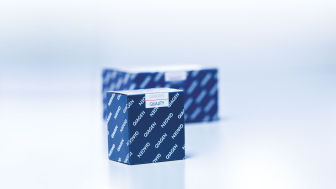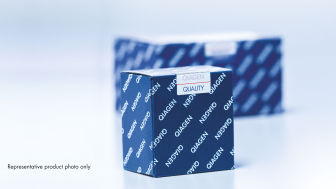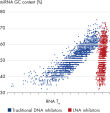



 下载产品说明书
下载产品说明书 用小程序,查商品更便捷
用小程序,查商品更便捷



 收藏
收藏
 对比
对比 咨询
咨询

Features
- Custom-designed antisense sterical blockers of miRNA and other short ncRNAs not in miRBase
- Tm normalization and LNA technology ensure high efficacy, even with AT-rich miRNAs
- Superior specificity and biological stability for long-lasting antisense activity
- Available in 1 nmol, 5 nmol and 15 nmol quantities
- Fluorescent labels for convenient monitoring of transfection efficiency
Product Details
Custom miRCURY LNA miRNA Inhibitors efficiently inhibit target miRNA activity, enabling you to perform miRNA functional studies on sequences not in miRBase. These antisense oligonucleotides have perfect sequence complementary to their targets, and when introduced into cells, they sequester the target miRNA in highly stable heteroduplexes that prevent interaction with the normal cellular partners.
Need a quote for your research project or would you like to discuss your project with our specialist team? Just contact us!Performance
See figures
Principle
miRCURY LNA miRNA Inhibitors are antisense oligonucleotides with perfect sequence complementary to their targets. When introduced into cells, they sequester the target miRNA in highly stable heteroduplexes, effectively preventing the miRNA from hybridizing with its normal cellular interaction partners.
The potency of miRNA antisense inhibitors is determined by their affinity for their miRNA target and their biological stability. The affinity of normal inhibitors with conventional nucleotide chemistry is a function of the GC content of the miRNA target. Since the GC content of miRNAs can vary from 5–95%, potencies of such inhibitors will vary greatly according to the miRNA sequence, with essentially no potency with AT-rich miRNAs.
Design
We have exploited the high affinity properties of LNA chemistry to create Tm-normalized miRCURY LNA miRNA Inhibitors and miRCURY LNA miRNA Power Inhibitors. Varying the numbers and positions of LNA nucleotides in these DNA/LNA mixmer inhibitors and carefully choosing the target sequences normalizes the melting temperatures of the oligonucleotides within a narrow window around an empirically determined optimal high temperature (see figure Overall features of the third-generation miRNA inhibitor design). These design features ensure that miRCURY LNA miRNA Inhibitors have the same high efficacy, regardless of the GC content of their miRNA targets.
We provide the following two types of miRNA inhibitors:
- miRCURY LNA miRNA Inhibitors: these have normal phosphodiester nucleotide bonds, which are highly effective in most standard experiments
- miRCURY LNA miRNA Power Inhibitors: these have fully phosphorotioate (PS)-modified backbones, which are useful for challenging applications, such as difficult-to-transfect cell lines
miRNA silencing without transfection reagents
The combination of LNA and phosphorothioate modifications dramatically improves the stability of miRCURY LNA miRNA Power Inhibitors against enzymatic degradation, so the efficacy of Power Inhibitors is significantly better than the regular inhibitors (see figure Enhanced potency of miRCURY LNA miRNA Power Inhibitors). In fact, they are so stable and potent that they can be added directly to serum-containing culture medium without the need for transfection reagents, providing efficient miRNA inhibition via unassisted "naked" delivery, also known as gymnosis. This allows you to assess the consequences of miRNA silencing without worrying about confounding side effects from the transfection reagents.
Unassisted delivery does require significantly higher inhibitor concentrations, and uptake kinetics are generally slower than when using transfection reagents (see figure miRNA silencing via direct uptake (gymnosis) of Power Inhibitors). Furthermore, the ability to take up oligonucleotides directly from the culture medium varies significantly among cell lines.
Power Inhibitors are especially useful for complex applications, such as those involving difficult-to-transfect cells, highly expressed miRNA targets, long-duration experiments and when normal transfection procedures result in unacceptable phenotypic consequences.
miRCURY LNA miRNA Power Inhibitors are not recommended for use with cells or cell lines derived from muscle or the central nervous system (CNS). These cell types are known to be particularly sensitive to phosphorothioate-modified oligonucleotides, which may give misleading phenotypes that are unrelated to antisense activity.
Minimal toxicity and off-target effects
The high potency of miRCURY LNA miRNA Inhibitors and miRCURY LNA miRNA Power Inhibitors allows them to be used at low concentrations, minimizing the risk of undesired secondary effects unrelated to the antisense activity.
DNA/RNA duplexes are a substrate for RNase H, which degrades the RNA strand, and we use this catalytic activity in our GapmeRs for RNA silencing. To ensure that our miRNA inhibitors do not degrade mRNA and long non-coding RNAs that happen to contain a complementary sequence, we have positioned the LNA nucleotides such that they are never distanced by more than a few bases. LNA effectively inhibits RNase H activity, ensuring that the LNA inhibitor/RNA duplexes are not recognized as substrates by RNase H. As a result, off-target effects on mRNA and lncRNA stability are minimized. Finally, ribosomes have strong helicase activity that can effectively remove even LNA-enhanced, high-affinity, short oligonucleotides. Therefore, our inhibitors also have minimal effects on translation of mRNAs that have complementary sequences in the open reading frame.
Coverage
Predesigned miRCURY LNA miRNA Inhibitors and miRCURY LNA miRNA Power Inhibitors have been designed for all known human, mouse and rat miRNAs. Since many miRNAs are phylogenetically conserved, this set of inhibitors covers a large proportion of vertebrate and invertebrate miRNAs. These inhibitors are also available with fluorescein (6-FAM) labels. All miRNA inhibitors are desalted and delivered dried down in tubes in 1 nmol, 5 nmol and 15 nmol quantities.
Predesigned negative controls
We currently offer four predesigned negative controls, two for use with miRCURY LNA miRNA Inhibitors and two for use with miRCURY LNA miRNA Power Inhibitors. The miRCURY LNA miRNA Power Inhibitor Controls have phosphorothioate-modified backbones to match the miRCURY LNA miRNA Power Inhibitors.
For each category of inhibitor, we offer the following two controls:
- Negative Control A: no hits of >70% homology to any sequence in any organism in the NCBI and miRBase databases.
- Negative Control B: no hits of >70% homology to any human, mouse or rat sequence in the NCBI and miRBase databases; not recommended for use in plants










 危险品化学品经营许可证(不带存储) 许可证编号:沪(杨)应急管危经许[2022]202944(QY)
危险品化学品经营许可证(不带存储) 许可证编号:沪(杨)应急管危经许[2022]202944(QY)  营业执照(三证合一)
营业执照(三证合一)